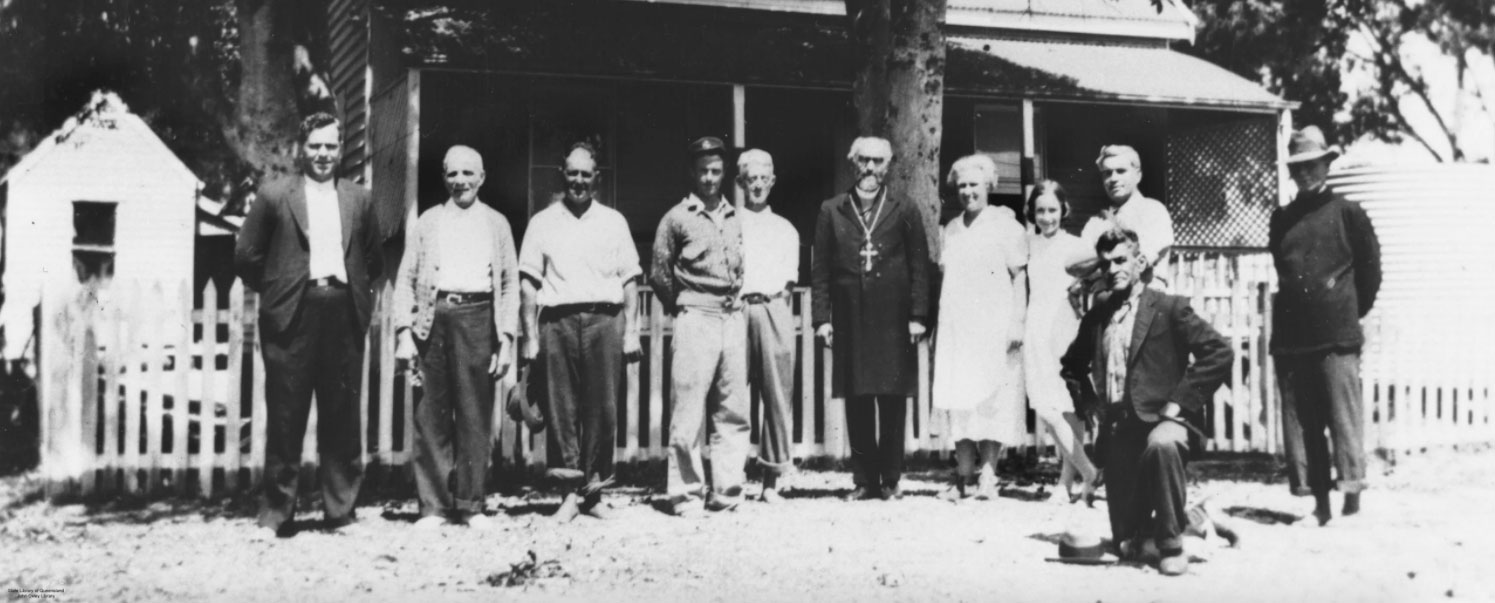The History of the Greek Orthodox Church in Australia
The Early Greek Orthodox Presence in Australia
Our Lord Jesus Christ has blessed Australia with the presence of his holy body, the Orthodox Church, in the early nineteenth century. In the middle of that century, the Orthodox Christian presence was felt when the Australian gold rushes began in 1851, when New South Wales and Victoria became “a migratory vortex” so that many Greeks from islands such as Kerkyra and Kefalonia deserted their vessels that had anchored in these states in order to make a living ‘down under.’ Evidence is sparse, but given the almost ubiquitous practice—especially over a century ago—of Greeks baptising their children into Orthodoxy for either religious or cultural reasons, it can safely be assumed that these were Orthodox Christians. We also have census records of Greek women from 1857 who are described as belonging to the “Greek Church,” which, of course, can only be the Orthodox Church.
The Greek Orthodox presence became more acknowledged from 1863 onwards either by visiting monastics who performed mysteries of the Church, or by visiting clergy who came to Australia just before 1898, when the establishment of Greek communities in Sydney and Melbourne took place. The first Greek Orthodox church, named after the Holy Trinity, was built on Bourke Street in Surry Hills in Sydney in 1898, initially in the Byzantine style before it was adorned with a Romanesque façade in 1931. Soon after, the church of the Annunciation was established in East Melbourne. In Queensland, the Greek Orthodox divine liturgy of St John Chrysostom was conducted for the first time in the precincts of the Hellenic Association of Brisbane on Adelaide Street in September 1915, and by the early 1920s a priest was appointed to conduct regular services; with the ‘the Greek Orthodox Community of St George’ soon coming into being. It was not until 1958 that Tasmania would have its first Greek church consecrated, also dedicated to St George the Martyr, in Hobart. A permanent church was not consecrated in Canberra in the Australian Capital Territory until 30 October 1968; it was named after St Nicholas of Myra.
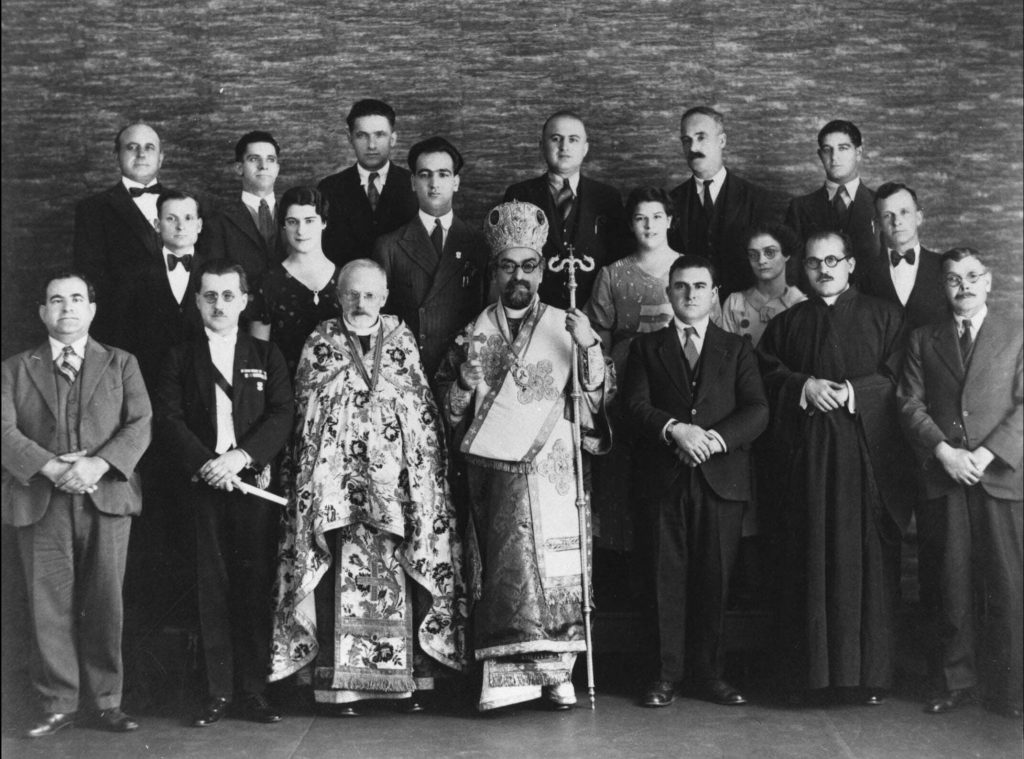
In 1922, the Kastellorizian Association purchased land for the first Orthodox church in Perth, Western Australia, after which a Pan-Hellenic organisation was set up to construct the ‘Hellenic Hall’ in 1924-25 where religious services were held. The first Greek Orthodox church-building in WA, named after Sts Constantine and Helen, was completed in 1936 and consecrated by Metropolitan Timotheos in 1937. In South Australia, “Greek church activity … began not in Adelaide but in Port Pirie, far to the north.” The first priest arrived in 1925 and by “November 1937 the foundation stone of the Church of the Archangels Gabriel and Michael” was laid on Franklin Street in Adelaide. In Darwin, in the Northern Territory, the first Greek priest had settled in September 1917, and in 1918 performed the first Orthodox baptism in the Territory in a small church “of bush timber and corrugated iron sheets” built by the local Greeks.
The Greek Orthodox Metropolis of Australia—later Archdiocese (from 1959-)—from Metropolitan Christophoros Knitis to Archbishishop Ezekiel (1924-1975)
In March 1924, the Ecumenical Patriarchate of Constantinople—whose Primate is the ‘first among equals’ in the hierarchical structure of Orthodox Christianity—during the time of Gregory 7th (1923-1974), founded the Holy Metropolis of Australia and New Zealand. Its first Metropolitan, Christophoros Knitis, an Oxford doctoral graduate who had during the first world war “organised soup-kitchens which served meals to needy Greeks” and had “gathered orphans and refugees into an asylum,” was mistreated by the community in Sydney and hounded out of the country five years after his appointment. He returned to his home island of Samos in 1929.
Metropolitan Christophoros was succeeded by Metropolitan Timotheos Evangelinidis. Born Tilemachos Evangelinidis in the village of Polychnitos, on the island of Lesbos, on 23 April 1880, he studied at the Evangelical School of Smyrna and the Great School of the Nation in Constantinople, before becoming a monk and serving as protosynkellos—which is the title given to the most senior cleric under a bishop—in this case the Metropolitan of Methymna, Stephen, until 1910. He then studied in the Ecumenical Patriarchate’s holy Theological School of Halki until 1914, before going to Bucharest in Romania and serving as parish priest for the local Greek community and teaching in the city’s Greek college. In 1921 and for the next ten years, he served as apokrisiarios or official representative of the Patriarchate of Constantinople to the Romanian Orthodox Church. Evangelinidis was elected as the second Metropolitan of Australia and New Zealand in 1931. In the interim, Father Theophylactos Papathanasopoulos had presided over the Greek Orthodox Metropolis of Australia and New Zealand until Metropolitan Timotheos arrived on 26 January 1932, on Australia Day. On 16 January 1947, Metropolitan Timotheos was elected to head the Metropolis of Rhodes, putting an end to his tenure as Primate of the Greek Orthodox Church in Australia. In June 1949, he was elected Archbishop of North and South America but was unable to assume this post due to a cardiac arrest. Unable to travel, he was re-instated as Metropolitan of Rhodes until his death in Istanbul (Constantinople) on 6 October, 1949.
Metropolitan Timotheos’ successor, Fr Theophylactos Papathanasopoulos mentioned above, had already helped to facilitate the transition between the tenures of Knitis and Evangelinidis and was therefore the natural choice to lead the Greek faithful in the Antipodes. Evangelinidis had appointed Fr Papathanasopoulos as the Ecumenical Patriarch’s Episcopal Representative in Melbourne, and, following his election on 22 April 1947 as Metropolitan, he went to Greece to be consecrated and spent some time at the monastery of Stavronikita, Mount Athos. He proceeded to his new post, reaching Perth on 19 April 1948. He was enthroned in Sydney on 13 June, in the presence of a congregation that included Greek, Russian and Syrian clergy. His tenure was tragically cut short when he died on 2 August 1958 in the Alfred Hospital, Melbourne, from injuries received in a car accident two days earlier.
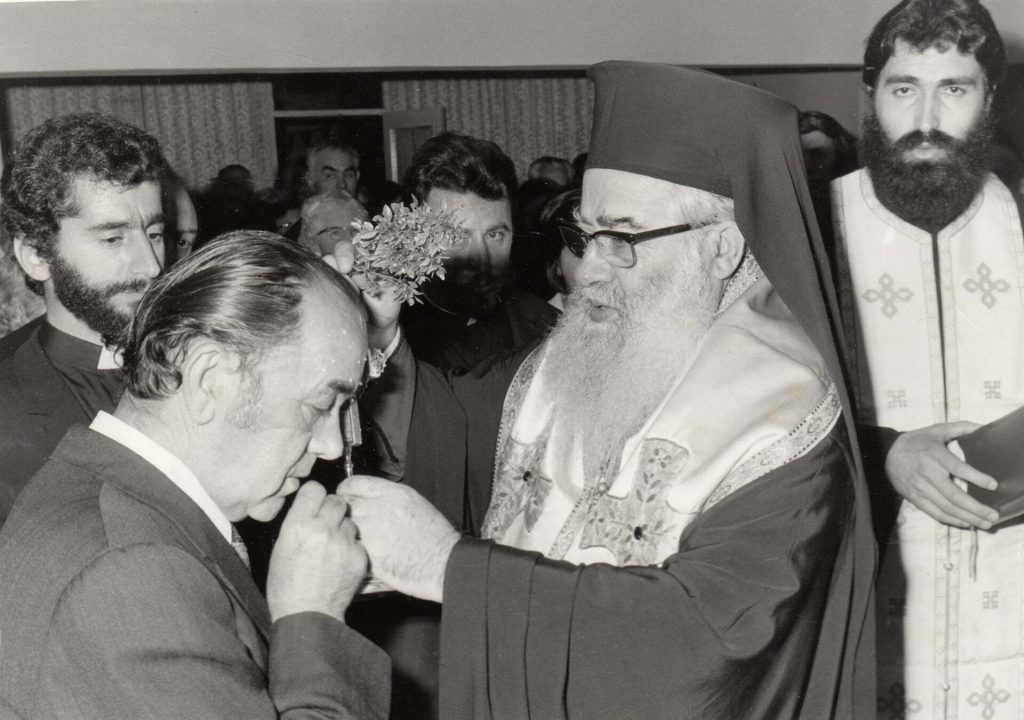
In 1959 the Bishop of Nazianzos, Ezekiel (Tsoukalas) was sent to the Metropolis of Australia and New Zealand, having been assistant bishop in the Archdiocese of America as well as Director of Holy Cross Theological School in Boston. On 1 September 1959, the Ecumenical Patriarchate elevated the Holy Metropolis of Australia and New Zealand into an Archdiocese and its leader became the first Archbishop of Australia and New Zealand. Archbishop Ezekiel inaugurated: the first mixed council of the Archdiocese consisting of both clergy and laity; the first central ladies philoptochos with representatives from the parishes; St Andrew’s brotherhood for the improvement of Archdiocesan services—all between the years 1960-61. In 1961 the first Clergy-Laity Congress was held in Sydney, and on 4 October of that same year, the title deeds were exchanged for the final purchase of land for the Holy Monastery of St George in Springwood (now Yellow Rock); a gift to the Greek Orthodox Archdiocese by Mr Dimitrianos and Mrs Helen Friderikos, the latter being spiritually prompted by the Mother of God, our Lady and Ever-Virgin Mary, to do so. St George is the first Greek Orthodox monastery in Australia, and in recent years the holy and miracle-working icon of the Mother of God ‘Kitrinopetritissa’ (Κιτρινοπετρίτισσα, literally ‘of Yellow Rock’ in Greek) was commissioned to commemorate another miracle-working icon, with her feast day on 4 October becoming the first Australian event to be recorded in the synaxarion of feasts of the Orthodox Church.
Archbishop Ezekiel oversaw two more Clergy-Laity conferences in 1965 and 1972, and in the interim, in 1970, “New Zealand was separated from the Greek Orthodox Archdiocese of Australia, having been established as a Metropolis by the Ecumenical Patriarchate.” In 1967 Archbishop Ezekiel purchased the historic St Paul’s Anglican church at 242 Cleveland Street, Sydney. This church was originally designed in the nineteenth century by Edmund Blacket, whose decorated Victorian Gothic style is characteristic of much church and university architecture throughout NSW. The church became consecrated as the Greek Orthodox cathedral of the Annunciation of Our Lady, and remains the cathedral of the Archdiocese to this day. In 1970, homes for the aged known as ‘Vasilias’ (St Basil’s Homes) were placed under the patronage of the Greek Orthodox Archdiocese. St Basil’s Homes can now be found in several locations throughout Sydney delivering “care to over a thousand frail aged clients while employing hundreds of qualified staff,” and its example inspired the Archdiocese to establish St Basil’s homes in other parts of Australia.
Archbishop Ezekiel’s notable desire to found a theological high school to teach Greek-Australians the Greek language and basic religious and theological courses—after which they would be sent to Halki seminary to complete their studies—fell through; not the least because of the closure of Halki by the Turkish authorities in 1971 and the difficulties, at the time, of practically implementing such a vision. By God’s grace, after a lengthy and successful tenure in Australia, in August 1974 the Ecumenical Patriarchate promoted Archbishop Ezekiel to the Metropolis of Pisidia where he remained until 1987. He died in Athens in July 1987.
The Greek Orthodox Archdiocese of Australia under Archbishop Stylianos (1975-2019)
On 3 February 1975 the Holy and Sacred Synod of the Ecumenical Patriarchate chose Metropolitan Stylianos of Miletoupolis (Harkianakis), lecturer at the University of Thessaloniki—and later an accomplished poet—as the new Archbishop of Australia. The new Prelate arrived in Sydney on the 15 April 1975 and was officially enthroned on Lazarus Saturday on 26 April 1975.
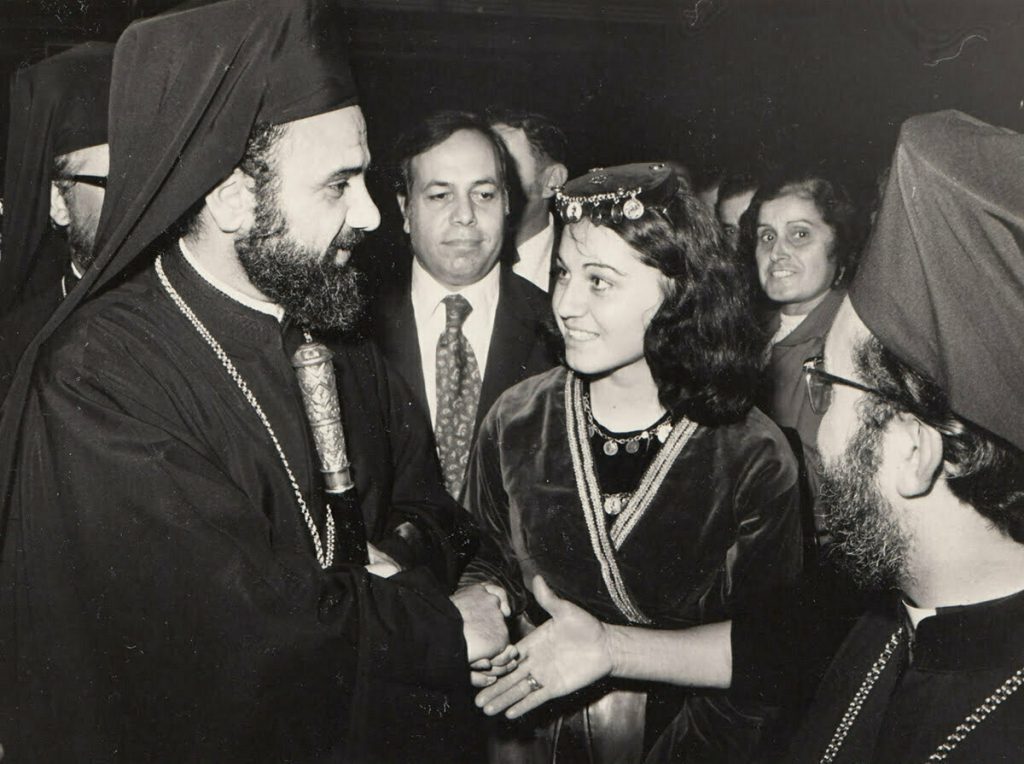
During the period of Archbishop Stylianos’ tenure, new priests were ordained, holy churches were consecrated, more sacred monasteries were founded and Greek Orthodox Schools, Colleges and Child Care Centres as well as the Greek Welfare Centre was founded. The Assembly of Canonical Orthodox Churches in Australia (SCOCCA) was established. During the same time the panegyric celebration of the 50 year anniversary of the Holy Archdiocese was held after a two year delay, and it had a major impact not only on those of Greek Orthodox heritage but also on the wider Australian public. Historically, the Clergy-Laity Conferences were also significant with the 4th (Sydney, 1981), 5th (Brisbane, 1985), 6th (Melbourne, 1989), 7th (Sydney, 1993), 8th (Sydney, 1998), 9th (Sydney, 2003), 10th (Sydney, 2008) and 11th (Sydney, 2013) taking place during the Archbishop’s tenure. The ten Pan-Australian Youth Conferences were also worthy of note, having become a reality from 1982, in Melbourne, Sydney, Adelaide and Brisbane, as well as local Youth Conferences respectively in each State. A significant milestone in the history of the Church was the founding and the functioning of St Andrew’s Greek Orthodox Theological College, which was officially recognised as being on the same level as other University Schools of Australia and Greece, as well as the College’s academic journal, Phronema, which is the only peer-reviewed Orthodox journal in the southern hemisphere.
A special stage in the life of the Church in Australia that took place during Archbishop Stylianos’ tenure was the historical visit by His All-Holiness, the Ecumenical Patriarch Bartholomew—‘first among equals’ in the Orthodox Church—to the Antipodes in November 1996. The Ecumenical Patriarch visited Australian cities, and he was welcomed by clergy, the Christian people and the heads of State with much honour and respect. Archbishop Stylianos also organised for elders from Greece to visit Australia for the spiritual nourishment and edification of the faithful; this included the visit of St Paisios the Athonite in the late 1970s.
During the annual celebrations in 2000, the holy Archdiocese convened the Millennium Heritage Council throughout all the States. From this was founded:
- The 200 member choir of the Archdiocese (Millennium Choir) which contributed to the celebrations accompanying the Olympic Games in Sydney 2000.
- The pioneering organisation ‘Provicare’ which aimed to care for the constantly growing numbers of victims of alcohol and drug abuse.
- The publishing firm of the Archdiocese, St Andrew’s Orthodox Press with publications by St Andrew’s Theological College.
Unfortunately, the first two of these three organisations have weakened or have ceased to exist. However, at the initiative of our new shepherd and Archbishop Makarios of Australia, a national School of Byzantine Music has been established; drug and alcohol abuse rehabilitation centres are being set up in Melbourne and Sydney; and St Andrew’s Orthodox Press has been revived (more on these below).
On 25 March 2019, Archbishop Stylianos reposed in the Lord, receiving “release from his labours” and passing “away to the life which knows no toil.” He left a precious spiritual heritage to the Greek Orthodox Church in Australia. His funeral was held on the 31st of the same month and year, at the Holy Cathedral of the Annunciation of Our Lady in Sydney.
Our New Shepherd, His Eminence Archbishop Makarios of Australia (2019)
On 9 May of the same year, the Holy and Sacred Synod of the Ecumenical Patriarchate, on the motion of His All-Holiness, Ecumenical Patriarch Bartholomew, chose unanimously as new Archbishop of Australia His Grace Bishop Makarios of Christoupolis, who was assistant Bishop of the Patriarch and Director of the Theological School of the Autonomous Church of Estonia. His Eminence Archbishop Makarios (Griniezakis) of Australia is therefore the sixth Primate of the Greek Orthodox Archdiocese of Australia.
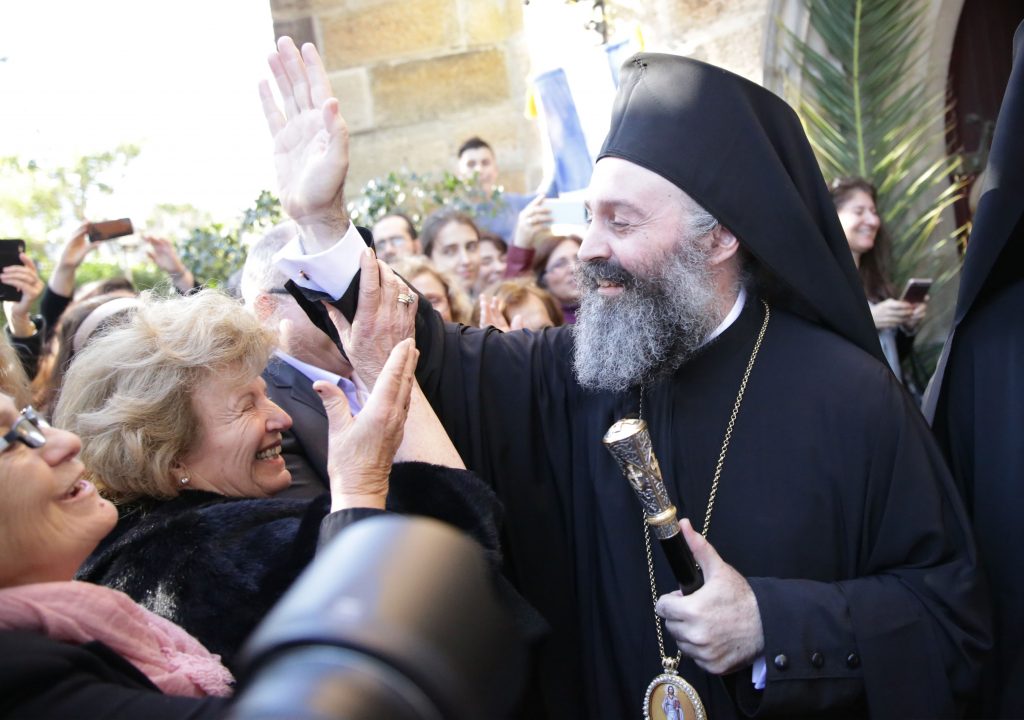
Archbishop Makarios was born in Heraklion, Crete, in 1973. Graduating from the Higher Ecclesiastical School of Athens and from the University of Athens’ School of Theology, he pursued graduate studies at Boston University (Master of Sacred Theology), Harvard (Master of Arts), and Monash (Master of Bioethics), and the Medical School of the University of Crete, from where he received his doctorate. He taught at the Higher Ecclesiastical Academy of Heraklion and has occasionally lectured in courses at various universities, including the Theological College of Holy Cross in Boston and the Medical Schools of the University of Crete, Thessaly, and Athens. He was also the Dean of the Department of Orthodox Studies of the Autonomous Church of Estonia. He has also published many books in Greek on topics ranging from Orthodox spirituality, priestly formation, and bioethics.
Archbishop Makarios was tonsured a monk and ordained deacon on 18 October, 1993; and he was ordained a priest on 25 June, 1997, at the Monastery of Saint George Epanosifis. On Easter Sunday 2008, Ecumenical Patriarch Bartholomew elevated him to the rank of Archimandrite of the Ecumenical Throne at the Phanar, Istanbul. He served as deacon at the Holy Cathedral of St Minas in Heraklion and as the parish priest of St Nicholas in Haraso and of the community of St George in Southbridge, MA.
On 18 June 2019, Kingsford Smith International Airport in Sydney became like a great cathedral filled with the Holy Spirit when our Archbishop arrived to greet scores of Greek faithful chanting Orthodox hymns such as Εὐλογητὸς εἶ Χριστὲ ὁ Θεὸς ἡμῶν (‘Blessed are You Christ our God’) and Σῶσον, Κύριε τὸν λαόν Σου (‘Save O Lord Your People’) amid resounding acclamations of Ἄξιος! (‘He is Worthy!). This constituted a tremendous witness to holy Orthodoxy to the Australian public and was an expression of the love for and unity between the new Archbishop and his flock. On 29 June, on the feast day of Saints Peter and Paul, he was officially enthroned as Archbishop of Australia at the Greek Orthodox cathedral of the Annunciation of Our Lady in Sydney in the presence of hierarchs from throughout the Orthodox world and representatives from the Australian government. His Eminence then embarked on trips to visit as many Greek Orthodox parishes, monasteries, schools and philanthropic institutions throughout Australia as he could; to encounter his flock and spiritual children and convey to them his blessing and the Lord’s.
On 25 December 2019 His Eminence elevated his Vicar-General of our holy Archdiocese His Grace Emilianos as Bishop of Meloe, which was followed by two more ordinations to the episcopate: Archepiscopal Vicar of Perth His Grace Bishop Elpidios of Kyaneon (on 18 January 2020), and Archepiscopal Vicar of Adelaide His Grace Bishop Silouan of Sinope (on 19 January 2020). Their Graces Elpidios and Silouan are, along with His Grace Iakovos of Miletoupolis (Archepiscopal Vicar of Brisbane), graduates of St Andrew’s Greek Orthodox Theological College, Sydney, of which His Eminence Archbishop Makarios is also Dean.
His Eminence Archbishop Makarios has been instrumental in rallying the faithful to financially support fellow Australians afflicted by the terrible bushfires that raged throughout the country in the summer of 2019-2020. At his nameday celebrations on 19 January 2020, His Eminence unveiled his plans for future projects that will equip the Greek Orthodox Archdiocese of Australia to spiritually nurture its faithful and give witness to Orthodoxy—in a common and unified manner—to all of Australia. These initiatives are as follows: a National Metropolitan Choir; a publication on the History of Greeks in Australia that will be published in English and Greek; a Clergy-Laity Conference to take place in Sydney in 2021 that will commemorate the Greek War of Independence (1821-2021) with the general theme ‘For Faith and Country’; a National Youth Conference in 2021; centres to combat drug dependency, such as the new ELPIS centre in Melbourne; a new purpose-built facility to house St Andrew’s Greek Orthodox Theological College, as well as renovation work to the Archdiocese to give greater witness to holy Orthodoxy in Australia; a new Archdiocesan School of Byzantine Music; new English speaking parishes; a potential new monastery; and additional nursing homes.
In fulfilment of his desire to see, meet, and hear from young people, His Eminence was present at the State-based Youth Conferences held in Melbourne (25 January), Perth (8 February), Brisbane (15 February), and Sydney (29 February) in 2020. Plans to visit the youth again in Northcote on 14 March and Adelaide on 11 April have been postponed due to the outbreak of COVID-19.
His Eminence has also reinstated St Andrew’s Orthodox Press, with the publication of his first book translated into English, Lord and Master of my life, having been released in April 2020.
The Greek Orthodox Archdiocese of Australia—which is part of Christ’s body that comprises the Orthodox Church throughout the world—with thanksgiving to God joyfully experiences this next chapter of its journey to Christ and witness to holy Orthodoxy under the erudite and loving leadership our new spiritual Father, His Eminence Archbishop Makarios of Australia.
